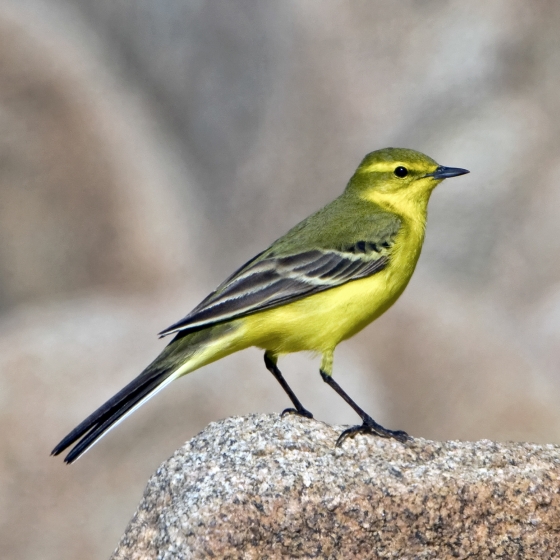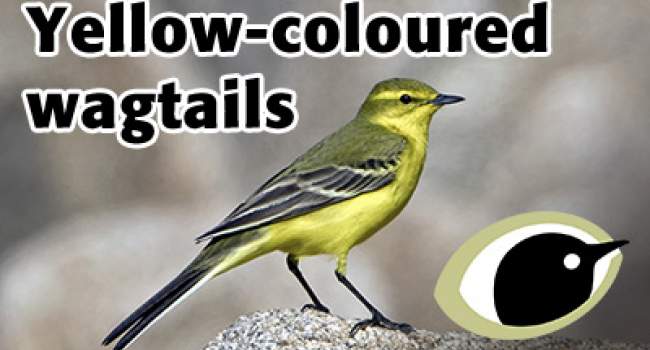Yellow Wagtail
Motacilla flava (Linnaeus, 1758)
YW
 YELWA
YELWA  10170
10170

Family: Passeriformes > Motacillidae

The Yellow Wagtail is a summer visitor, breeding primarily in southern and eastern Britain.
This is a strongly migratory species, wintering in trans-Saharan Africa and returning from early April to breed in grassy habitats, particularly in proximity to cattle. There has been a major decline in numbers since the 1970s, albeit with more stability over the last decade. The decline appears strongly linked to agricultural intensification.
Along with the decline in numbers, the Yellow Wagtail has also undergone range contraction. Most of our breeding birds are now found in central and northern England. It is extinct as a breeding bird on the island of Ireland, where is now only found while on passage.
Exploring the trends for Yellow Wagtail
Our Trends Explorer will also give you the latest insight into how the UK's Yellow Wagtail population is changing.
trends explorerIdentification
Yellow Wagtail identification is often straightforward. The following article may help when identifying Yellow Wagtail.
Identifying yellow-coloured wagtails

When is a yellow wagtail not a Yellow Wagtail? These bright-coloured summer visitors are declining across much of their range and a frequent mistake is believing that any wagtail showing yellow in its plumage is this species.
This video will help you separate individuals from the more widespread resident Grey Wagtail - which despite the name always shows yellow, and even juvenile Pied Wagtails.
SONGS AND CALLS
Listen to example recordings of the main vocalisations of Yellow Wagtail, provided by xeno-canto contributors.
Flight call
Call
Song
Develop your bird ID skills with our training courses
Our interactive online courses are a great way to develop your bird identification skills, whether you're new to the hobby or a competent birder looking to hone your abilities.
Browse training coursesStatus and Trends
Population size and trends and patterns of distribution based on BTO surveys and atlases with data collected by BTO volunteers.
CONSERVATION STATUS
This species can be found on the following statutory and conservation listings and schedules.
POPULATION CHANGE
Britain holds almost the entire world population of the distinctive race flavissima, so population changes in the UK are of global conservation significance. Yellow Wagtails have been in rapid decline since the early 1980s, according to CBC/BBS and especially WBS/WBBS and, after a shift from the green to the amber list in 2002, the species was moved to the red list in 2009 (Eaton et al. 2009). Gibbons et al. (1993) identified a range contraction towards a core area in central England, concurrent with the early years of decline. Further range contraction has occurred extensively since then, especially in the west and south and in parts of East Anglia (Balmer et al. 2013). The European trend, which comprises several races of the species, has shown a decline since 1980 (PECBMS: PECBMS 2020a>).
| UK breeding population |
-74% decrease (1967–2022) 
|
Exploring the trends for Yellow Wagtail
Our Trends Explorer will also give you the latest insight into how the UK's Yellow Wagtail population is changing.
trends explorerDISTRIBUTION
The majority of the UK's Yellow Wagtails now breed in England, with none breeding in Ireland and only a few squares occupied in Wales and Scotland during 2008–11. Densities are highest in East Yorkshire, Lincolnshire, the Fens, Broadland and the Essex and Kent coastal marshes.
Occupied 10-km squares in UK
| No. occupied in breeding season | 785 |
| % occupied in breeding season | 26 |
| No. occupied in winter | 11 |
| % occupied in winter | 0.4 |
European Distribution Map
European Breeding Bird Atlas 2
Breeding Season Habitats
| Most frequent in |
Arable Farmland, Estuaries 
|
| Also common in | Along Streams |
Relative frequency by habitat
Relative occurrence in different habitat types during the breeding season.

DISTRIBUTION CHANGE
Breeding Yellow Wagtails have been lost from many parts of southern England, northwest England, Wales, the Scottish Borders and the Central Belt. In the remaining range relative abundance has decreased with only East Lincolnshire and East Yorkshire showing signs of growth.
Change in occupied 10-km squares in the UK
| % change in range in breeding season (1968–72 to 2008–11) | -32.3% |
| % change in range in winter (1981–84 to 2007–11) | --85.7% |
SEASONALITY
Yellow Wagtail is a localised summer migrant, arriving in April; can be seen more widely during autumn passage, often at wetlands, but most have departed by October.

Movement
Information about movement and migration based on online bird portals (e.g. BirdTrack), Ringing schemes and tracking studies.
An overview of year-round movements for the whole of Europe can be seen on the EuroBirdPortal viewer.
RINGING RECOVERIES
View a summary of recoveries in the Online Ringing Report.
Foreign locations of birds ringed or recovered in Britain & Ireland

Biology
Lifecycle and body size information about Yellow Wagtail, including statistics on nesting, eggs and lifespan based on BTO ringing and nest recording data.
PRODUCTIVITY & NESTING
Exploring the trends for Yellow Wagtail
Our Trends Explorer will also give you the latest insight into how the UK's Yellow Wagtail population is changing.
trends explorerSURVIVAL & LONGEVITY
View number ringed each year in the Online Ringing Report
Maximum Age from Ringing 
|
7 years 1 months 14 days (set in 1982) 
|
Typical Lifespan 
|
3 years with breeding typically at 1 year |
Adult Survival 
|
0.533±0.031  
|
Juvenile Survival 
|
0.463 (in first year) 
|
Exploring the trends for Yellow Wagtail
Our Trends Explorer will also give you the latest insight into how the UK's Yellow Wagtail population is changing.
trends explorerBIOMETRICS
Wing Length 
|
Adults | 81.6±3 | Range 76–86mm, N=295 |
| Juveniles | 81.2±2.6 | Range 77-85mm, N=999 | |
| Males | 82.8±2.5 | Range 79–86mm, N=176 | |
| Females | 79.3±2.8 | Range 75–84mm, N=82 |
Body Weight 
|
Adults | 17.6±1.7 | Range 15.3–20.4g, N=270 |
| Juveniles | 17.9±1.7 | Range 15.5–21.0g, N=869 | |
| Males | 17.7±1.5 | Range 15.5–19.9g, N=159 | |
| Females | 16.9±1.8 | Range 15.0–21.3g, N=77 |
Feather measurements and photos on featherbase 
CODES & CLASSIFICATION
Ring size 
|
A |
Field Codes 
|
2-letter: YW | 5-letter code: YELWA | Euring: 10170 |
For information in another language (where available) click on a linked name
Research
Interpretation and scientific publications about Yellow Wagtail from BTO scientists.
CAUSES AND SOLUTIONS
Causes of change
Agricultural intensification is the ultimate cause of population declines. However, the mechanisms underlying the decline remain unclear.
Further information on causes of change
Changes in agricultural practices have been proposed as the main reason for declines via their impact on the quality of foraging and breeding habitats. The magnitude of Yellow Wagtail decline appears to vary between habitats, being strongest in wet grassland and marginal upland areas (Henderson et al. 2004, Wilson & Vickery 2005). Chamberlain & Fuller (2000, 2001) found that there were greater range contractions in regions dominated by pastoral agriculture. The decline in pastoral habitats has been proposed to be due to agricultural intensification, specifically farmland drainage, the conversion of pasture to arable land, changes in grazing and cutting regimes, the loss of insects associated with cattle and changes to grassland ecosystems in marginal upland areas (Gibbons et al. 1993, Chamberlain & Fuller 2000, 2001, Flyckt 1999, Vickery et al. 2001, Nelson et al. 2003, Bradbury & Bradter 2004, Henderson et al. 2004). Such changes are likely to have reduced the quality of grasslands as a nesting and foraging habitat.
Data from eastern England suggest a strong avoidance of grassland and preference for spring-sown crops (Mason & Macdonald 2000), though breeding can also be successful in landscapes dominated by winter cereals (Kirby et al. 2012). A detailed autecological study by Gilroy et al. (2008) provides good evidence that, on arable land, soil penetrability had a significant influence on the abundance of Yellow Wagtails, together with crop type and soil type, as these influenced invertebrate capture rates. There was a strong relationship between Yellow Wagtails and soil penetrability, suggesting a potential causative link between soil degradation and population decline (Gilroy et al. 2008). Breeding-season length may also be limited in cereal-dominated areas, as Yellow Wagtails avoid autumn-sown cereals late in the season (Gilroy et al. 2009, 2010). Predation was also considered and it was found that predation rate was closer nearer to tramlines and field-edges (Morris & Gilroy 2008). It is uncertain how important nest predation in tramlines is as a limiting factor for Yellow Wagtail populations but no studies have reported predation as a major driver of population decline for this species. Work carried out by Benton et al. (2002) showed that, in Scotland, arthropod abundance was significantly related to agricultural change and that this was also linked to measures of farmland bird density. Although Yellow Wagtail does not breed on Scottish farmland, it is an obligate insectivore, so this evidence adds support to the hypothesis that reduced food availability due to agricultural change may have contributed to the declines in this species.
Yellow Wagtails are long-distance migrants, moving to wintering grounds in western Africa south of the Sahara. Factors relating to conditions on the wintering grounds may also play a role (Bradbury & Bradter 2004, Heldbjerg & Fox 2008, Stevens et al. 2010) but evidence for this is lacking.
Information about conservation actions
The decline of the Yellow Wagtail since the 1980s is believed to be driven by agricultural intensification and resultant habitat changes, although the exact mechanism behind the decline is unclear and therefore specific evidence-based conservation actions to reverse the decline are limited. However, there is good knowledge about breeding habitat preferences.
The research suggests that changes to cattle farming and associated grassland may have reduced quality and food availability; hence actions which enable low intensity pastoral farming may benefit Yellow Wagtails, including a reduction in the use of fertilisers, herbicides and pesticides to provide more diverse semi-natural grasslands. A detailed study of Yellow Wagtail breeding ecology by Bradbury and Bradter (2004) provided good evidence of the species' breeding requirements on grassland. Territories were associated with a greater proportion of bare earth in the sward, the presence of shallow-edged ponds or wet ditches in the field, and a greater probability of a prolonged winter/spring flood, although the relative importance of these and how they impact on demographic processes was indecipherable.
Where Yellow Wagtails nest in arable fields, providing spring sown crops may help improve breeding productivity by extending the breeding season (Mason & McDonald 2000). Alternatively, providing a mosaic of crops may enable Yellow Wagtails to raise early broods in autumn sown cereal fields but switch to other crops (e.g. potatoes) for later broods (Gilroy et al. 2010).
Links to more studies from ConservationEvidence.com
- Effects of crop diversification and low pesticide inputs on bird populations on arable land
- Evaluating the English Higher Level Stewardship scheme for farmland birds
- The recent declines of farmland bird populations in Britain: an appraisal of causal factors and conservation actions
Read more studies about Yellow Wagtail on Conservation Evidence >
Would you like to search for another species?












Share this page